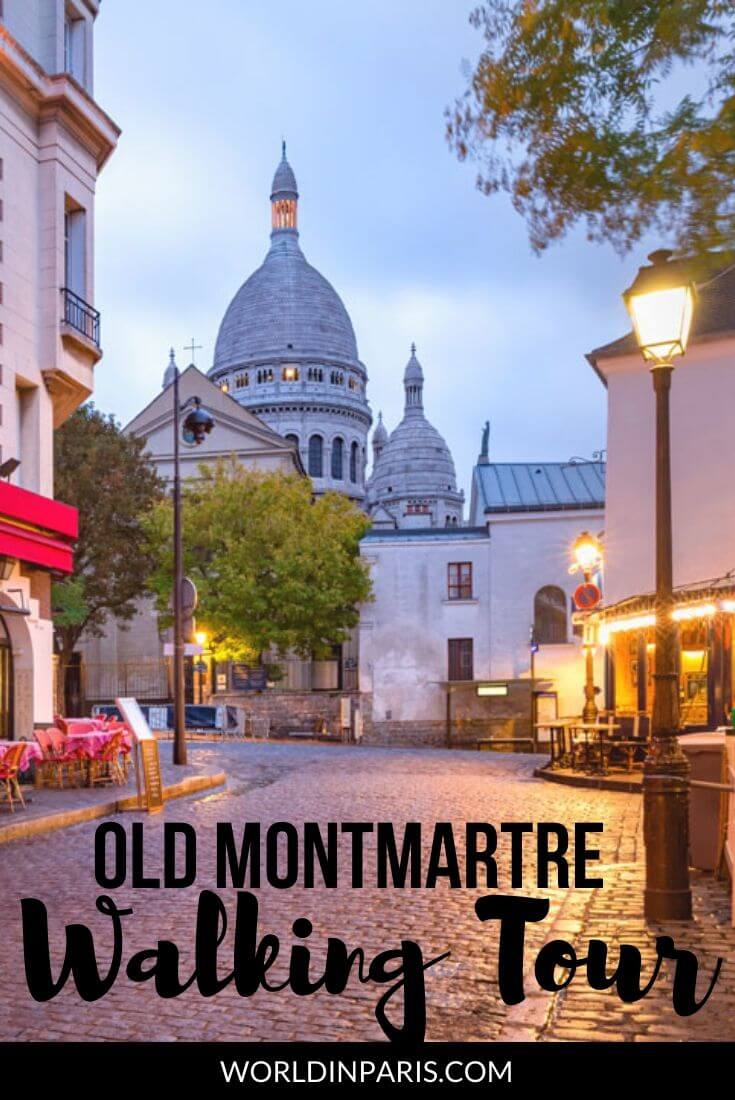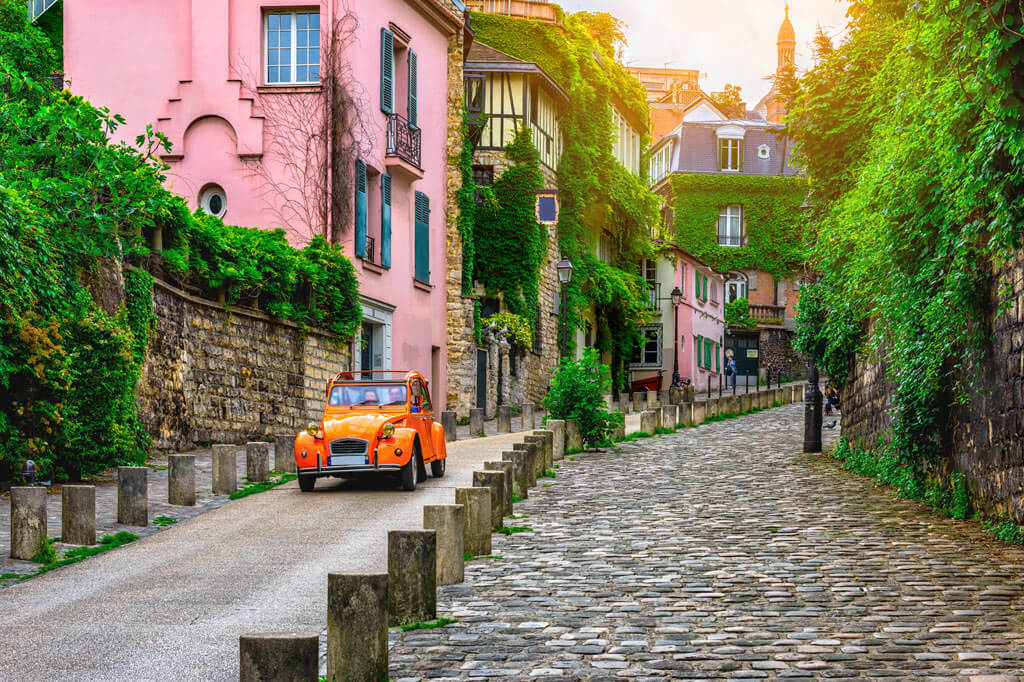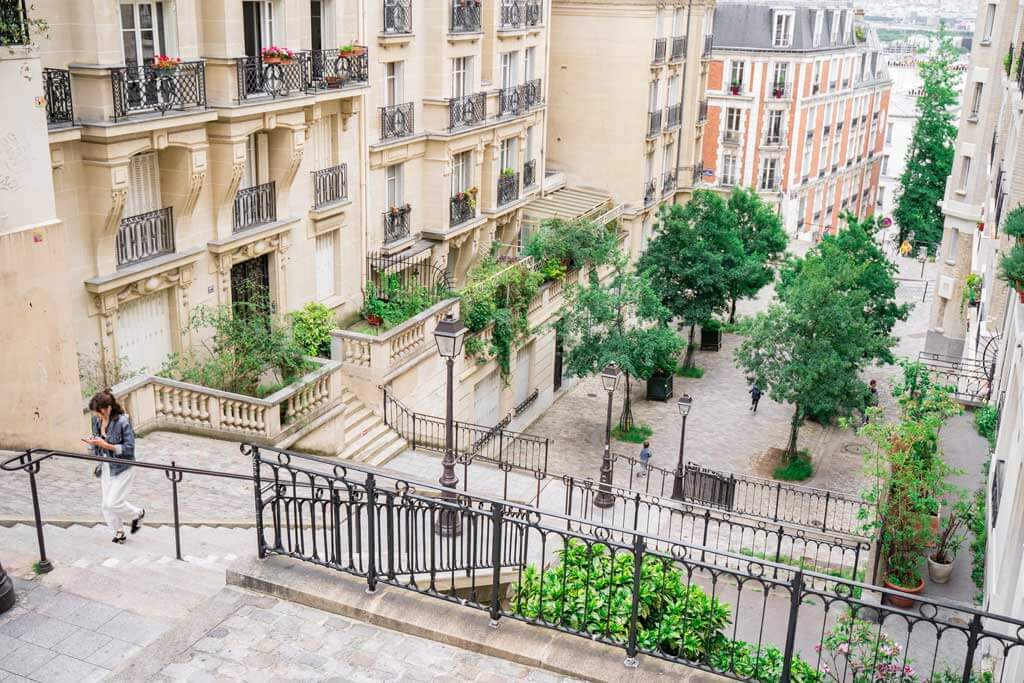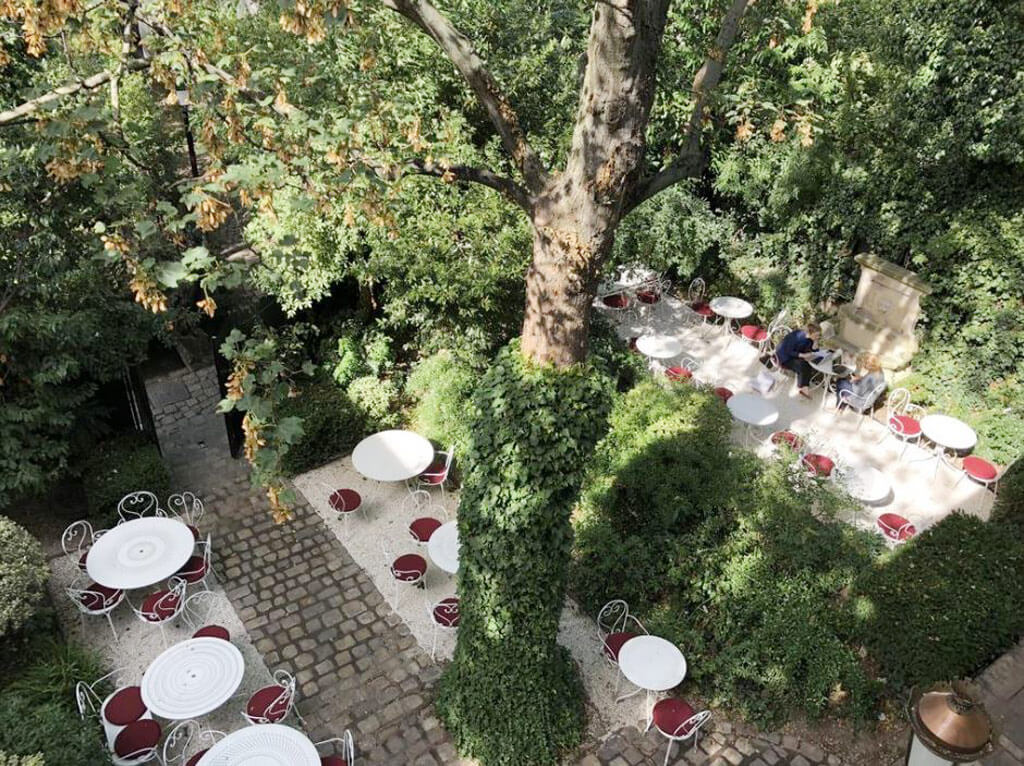Montmartre Self-guided Walking Tour
This Montmartre walking tour takes you through the main sights of old Montmartre and the stories and legends behind it.
The Montmartre Hill in Paris, also known as La Butte by locals, is famous for its Basilica of the Sacred Heart, the Love Wall, and its panoramic view of Paris. However, it is also a gastronomic and cultural district with authentic charm, dotted with many picturesque stairs and old lampposts.
Montmartre was an independent village from its origins until 1860 when it was annexed to Paris. Due to the beautiful light from ‘the heights’ and the low rents, the Butte was colonized by artists in the 19th century. When walking in Montmartre at that time, you could come across people like Corot, Géricault, Renoir, Degas, Cézanne, Max Jacob, Apollinaire, Juan Gris, Vlaminck, Braque, and Picasso!
Needless to say, the history of this neighborhood is fascinating and you will learn many quirky stories and fun facts during this walking tour of Montmartre.
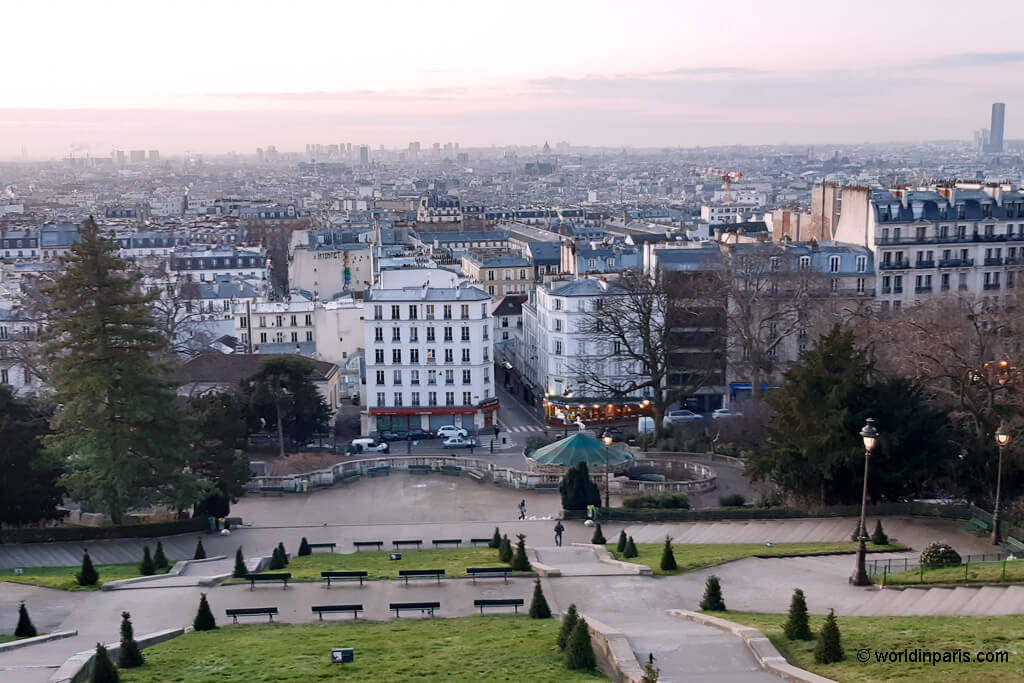
The neighborhood of Montmartre is one of the top places to visit in Paris. We recommend doing this Montmartre walking tour in the following Paris itineraries:
Montmartre Practical Information
How to Get to Montmartre?
Two metro lines operate within Montmartre Hill: lines 12 (green) and 2 (blue).
Montmartre is a hilly neighborhood with many staircases and cobbled streets. If you want to get to Montmartre from the airport and have a lot of luggage, we recommend booking a private transfer service like Welcome.
Where to Eat & Sleep in Montmartre?
Montmartre Walking Tour Map
Walking in Montmartre is a wonder as long as there are no tourist crowds. That’s why I recommend taking this Montmartre tour early in the morning, right after sunrise, when everything is still calm and quiet.
This Montmartre self-guided walking tour starts in front of the Sacré-Cœur Basilica, in the heart of the neighborhood. The starting point (Sacré-Coeur) is marked with #1 on this Montmartre walking tour map.
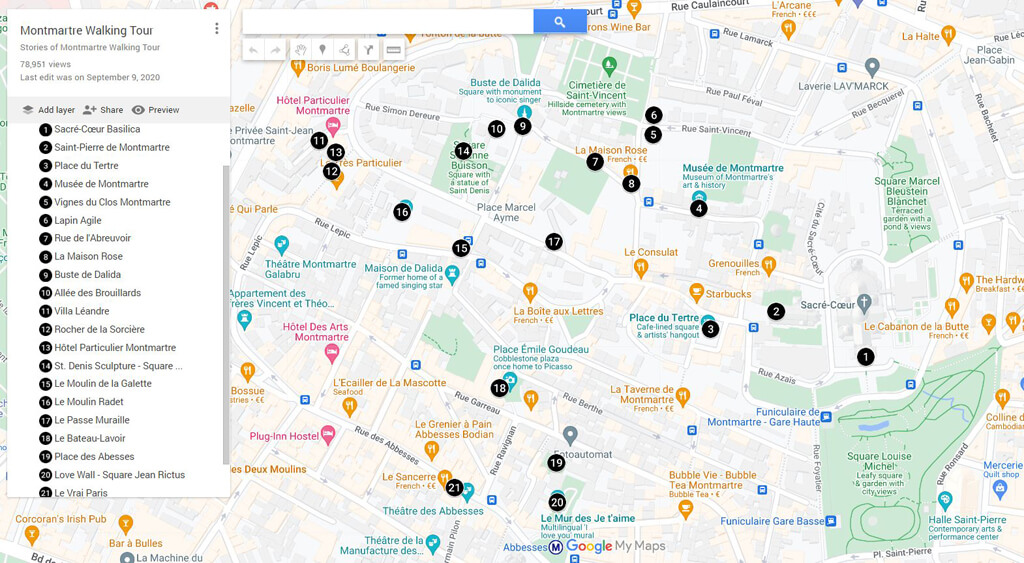
Walking Tour of Montmartre – Itinerary
1. The Secret of Sacré-Coeur’s Eternal Beauty
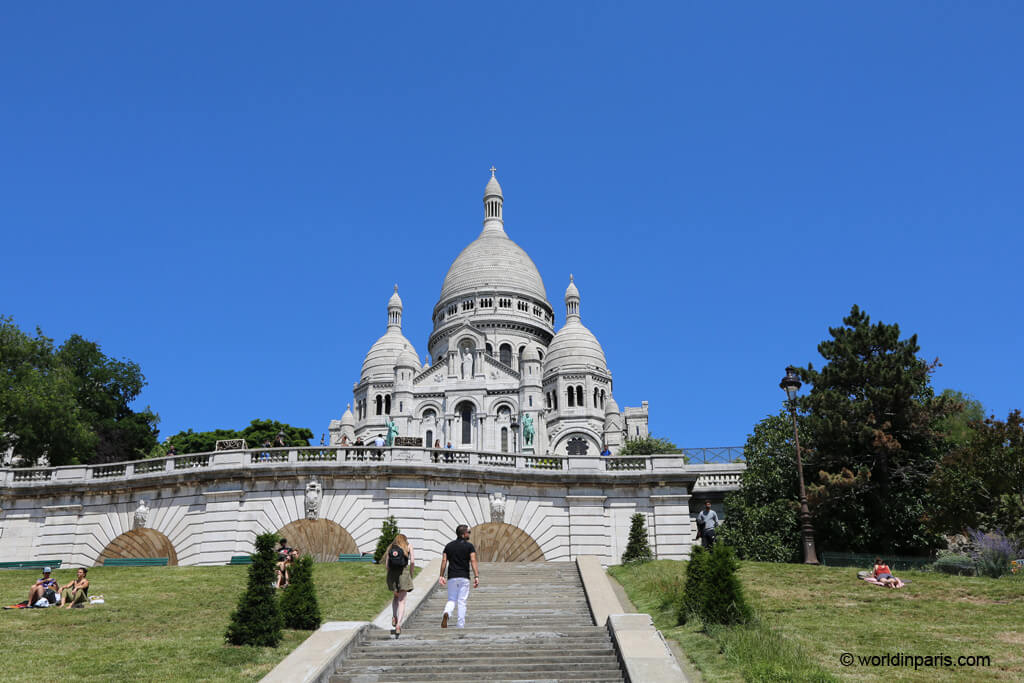
The Basilica of the Sacré-Coeur, located at the top of Montmartre Hill in Paris, is a major religious building built at the end of the 19th century. With more than ten million pilgrims and visitors per year (in 2006), it is the second most visited monument in France after Notre Dame de Paris Cathedral!
While most of the monuments of Paris tend to darken over time and are constantly subject to renovations, the Sacré Coeur is recognizable by its characteristic and unpolluted white color. How Montmartre’s symbol can stay so white?
The Sacré Coeur was built with the stone of Château-Landon, also used to build the Alexandre iii Bridge and the Arc de Triomphe. This stone has a very interesting characteristic: when it rains, it secretes a white substance in contact with water (the cullet) which flows along the walls of the building before hardening in the sun. This is Sacré- Coeur’s secret of eternal youth and the reason why it has never been renovated!
2. Saint-Pierre Church and the Myth of Saint-Denis
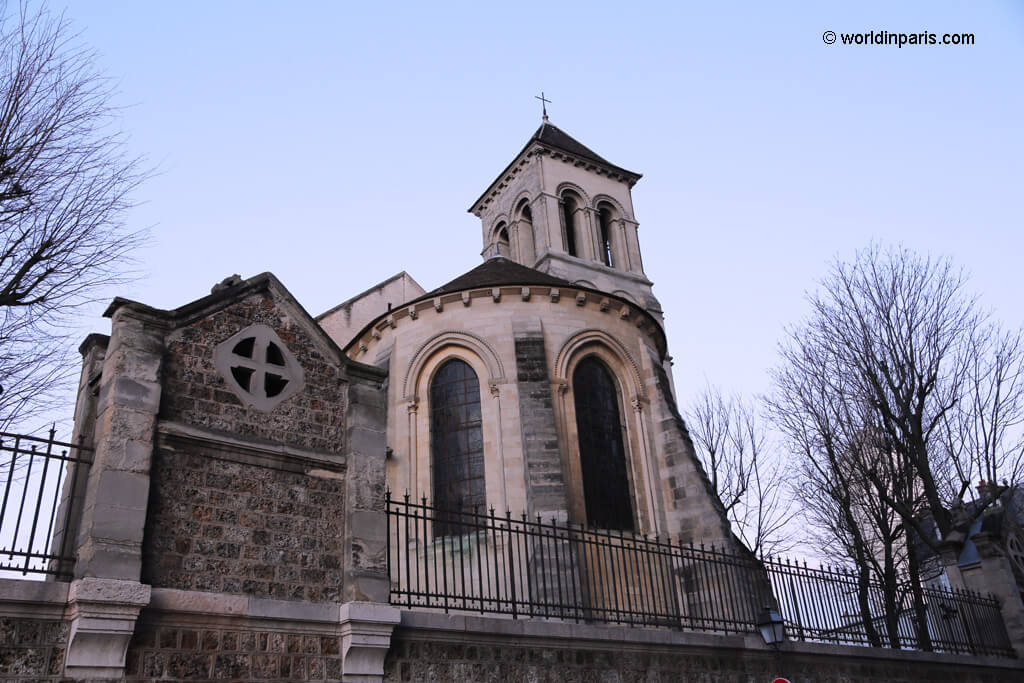
The next stop of this walking tour Montmartre is 2 rue du Mont-Cenis. Here, there’s one of the oldest churches in Paris, built in the Middle Ages.
Saint-Pierre Church is connected to the legend of Saint-Denis. The saint martyr was martyred on the Butte-Montmartre (Mount of Martyrs), which became a sacred place for Christians.
Before the Middle Ages, a temple dedicated to the Roman god of Mars stood at the site of the current church. This temple became in the 5th century a Merovingian chapel surrounded by a cemetery around which a small hamlet developed.
The site experienced a new development in the 12th century. In 1133, it was ceded with the Merovingian chapel to King Louis VI and Queen Adelaide of Savoy, who decided to found a Royal Abbey of Benedictine nuns in this place. In 1147 the Royal Abbey replaced the old chapel with a new church in Romanesque style (Saint-Pierre Church) and added more constructions around it.
During the troubles of the French Revolution, the parish worship spared Saint-Pierre Church while the rest of the religious buildings were demolished entirely. After being converted into a Temple of Reason (1794), and later transformed into a tower on which Claude Chappe installed his first aerial telegraph, Saint-Pierre Church was restored between 1899 and 1905.
Today, the church’s interior keeps its original Romanesque style, except for the Gothic rib vault and some Gallo-Roman parts recycled from the Merovingian chapel. Adjacent to the church there is the charming Calvary Cemetery, the oldest cemetery in Paris! The cemetery opens its doors only on 1 November and during the European Heritage Days.
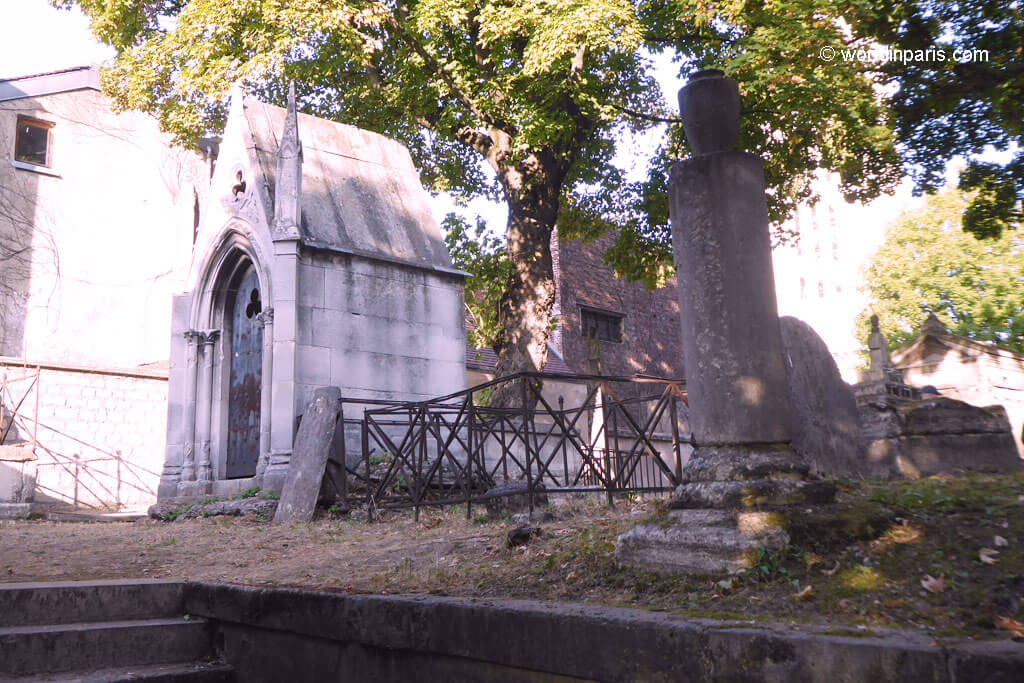
The hillock, dominated by Saint-Pierre Church and its public square (Place du Tertre), has long kept its village atmosphere. While the village’s fame has been widely exploited (you just need to see all those souvenir shops..) and completely distorted, the church retains a picturesque side with its clear perspective.
3. Place du Tertre and the Artists of Montmartre
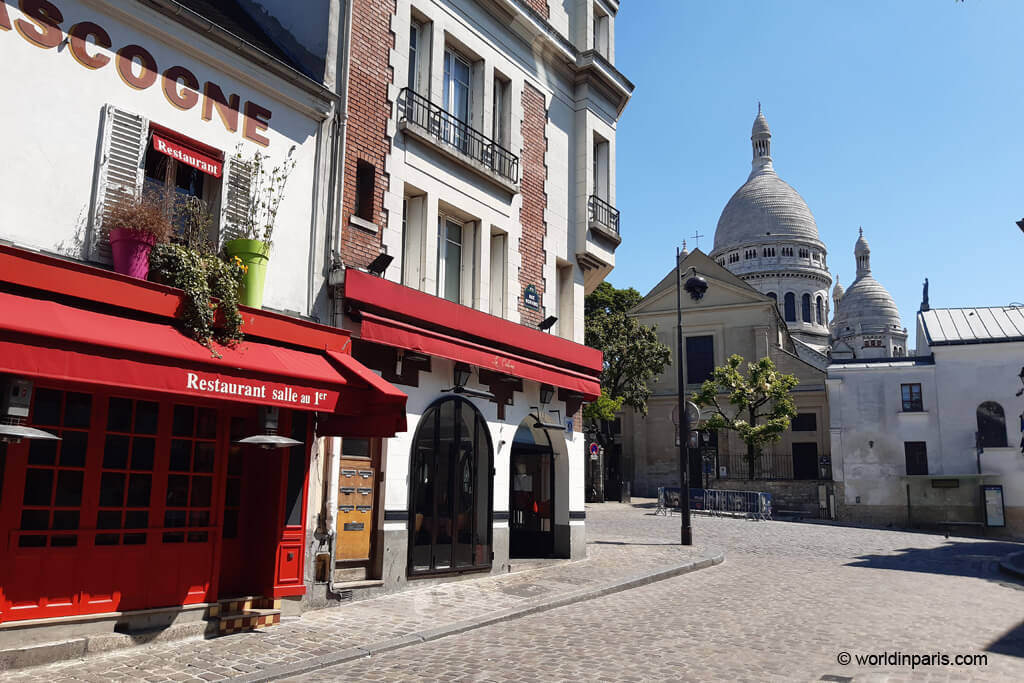
Place du Tertre is Montmartre’s beating heart. This picturesque square framed by 3-4 story 18th-century buildings and with a beautiful view over the Sacré Coeur corresponds to the center of the old village of Montmartre.
The village of Montmartre was officially founded in 1790, and its first town hall was at 3 Place du Tertre. In the square, there is also a plaque on the façade of house #21 which commemorates the arrival of the first automobile on Christmas Eve 1898, with Louis Renault behind the wheel. This event marks the beginning of the automobile industry in France.
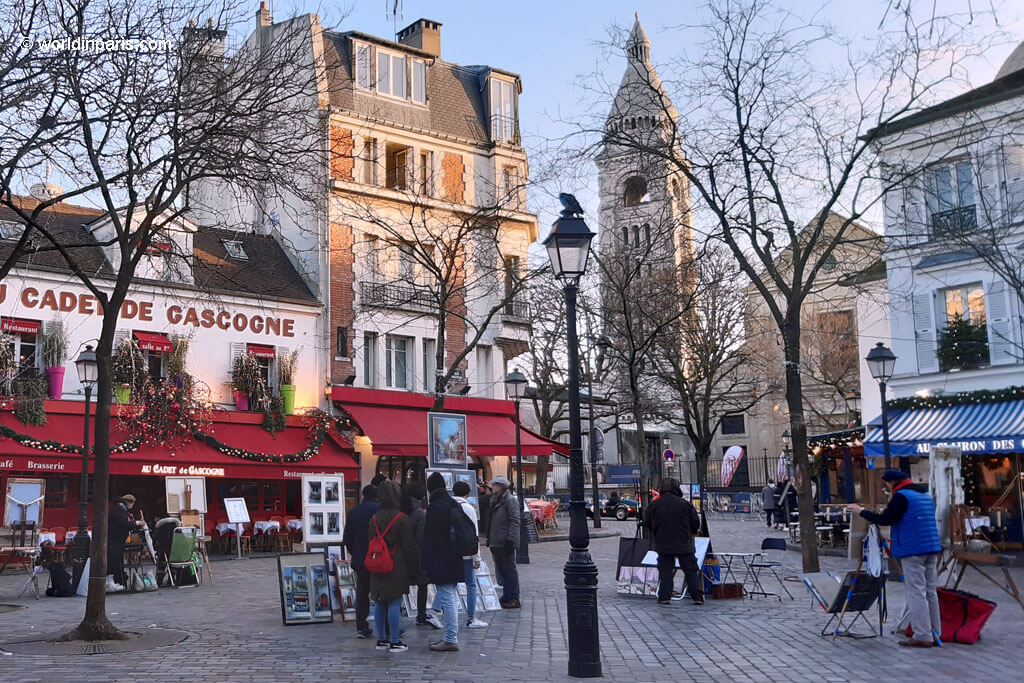
The local art trade is a tradition of the slopes of bohemian Montmartre, started around 1890 by famous Montmartre artists like Modigliani, Utrillo, Valadon, and Picasso. Each year, the City Council grants 140 licenses for a one-square-meter stall in Place du Tertre to be shared by two artists on alternating schedules.
Let’s take Rue Novins, the old village’s main street. This street was referred to in the 11th century as the cart road that goes from Montmartre to Paris. The even side is lined up with 18th-century townhouses with wooden shutters, wrought iron window railings, and dormers.
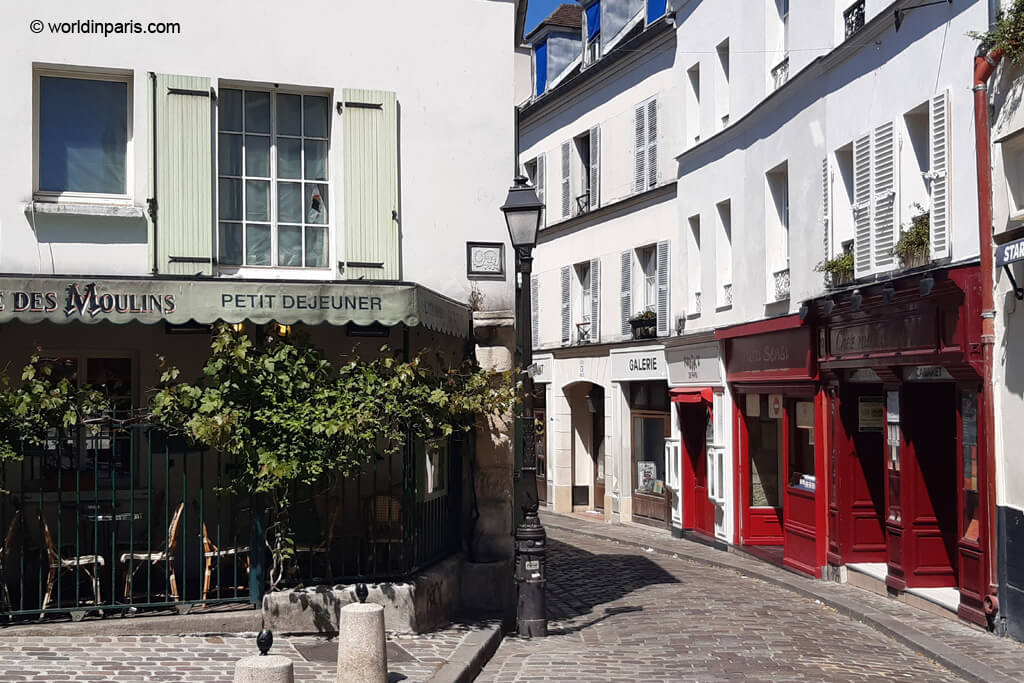
At #6 there’s the Mère Catherine Restaurant, a small bistro founded in 1793. This bistro replaced a 15th-century old presbytery, and guests liked to meet for drinking and to play wooden billiards. An old postcard shows the Mère Catherine and the pool players posing in front of the bistro.
Now, let’s turn left onto Rue des Saules, which plunges down the north side of the Hill. Don’t forget to take a picture of Le Consulat, one of the most Instagrammable cafés in Montmartre.
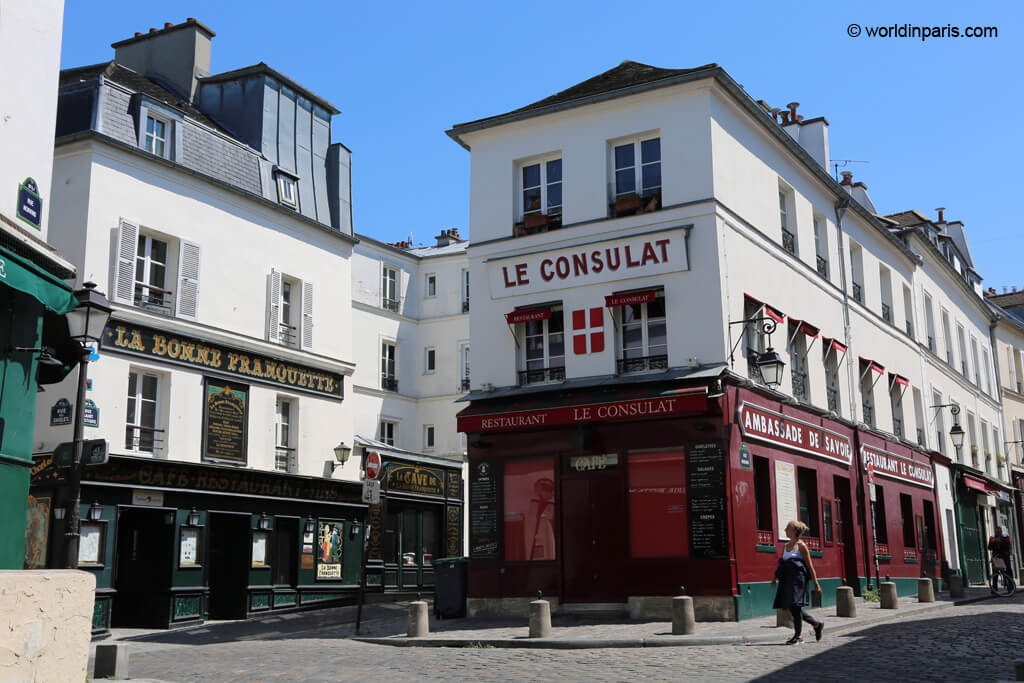
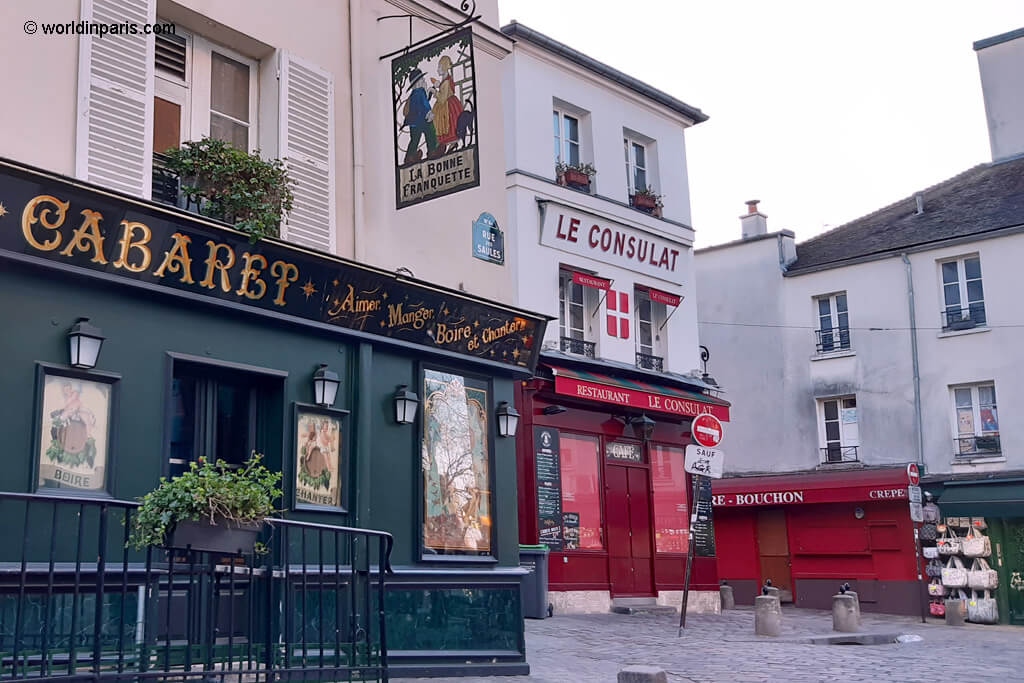
Rue des Saules was called in the 15th century the Chemin de la Saussaie, and it traversed swampy lands where willow trees (saules in French) grew. For this walking tour of Montmartre, you will take the second intersection with Rue Cortot.
4. A Hothouse for Artists
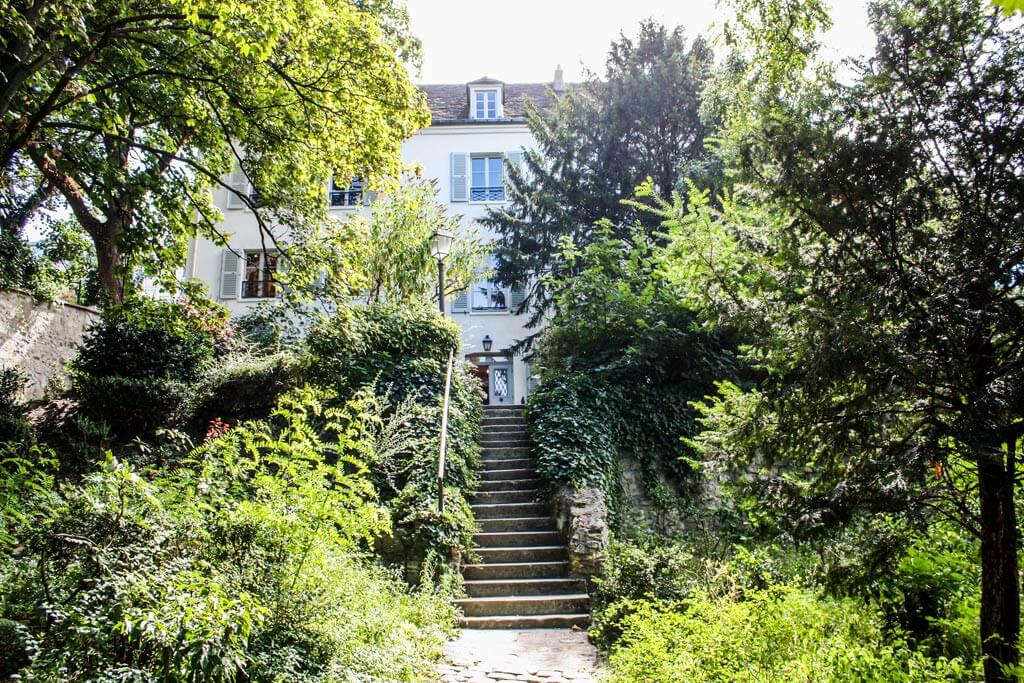
Considered the oldest house in Montmartre and formerly the art studio of many artists, Le Musée de Montmartre (12 rue Cortot) is nestled on a quiet street. Although the museum is located a stone’s throw from busy Sacré-Coeur, it feels a world away.
Auguste Renoir was perhaps its most illustrious guest. In 1876, He rented a studio and stables in the left wing to store Le Moulin de la Galette, the extra-large painting he was working in.
The rarely crowded museum has collections on the village’s history (the section on cabarets, for example, is very interesting). The setting is very romantic, and from the exterior areas, you are treated to excellent views over the vineyard of Montmartre. Take a drink in the beautiful café in the garden, immortalized by artists like Renoir in The Swing.
After the visit to the Musée de Montmartre, this Montmartre walk turns left on Rue du Mont-Cenis. This street was in the 12th century a steep path – only accessible to pedestrians and mules – which linked the Abbey of Saint-Denis to the Abbey of Montmartre through the Hill’s northern slope.
Then turn left onto Rue Saint-Vincent, a street with a provincial feel, and stop at Montmartre’s vineyards.
5. The Wine of Montmartre
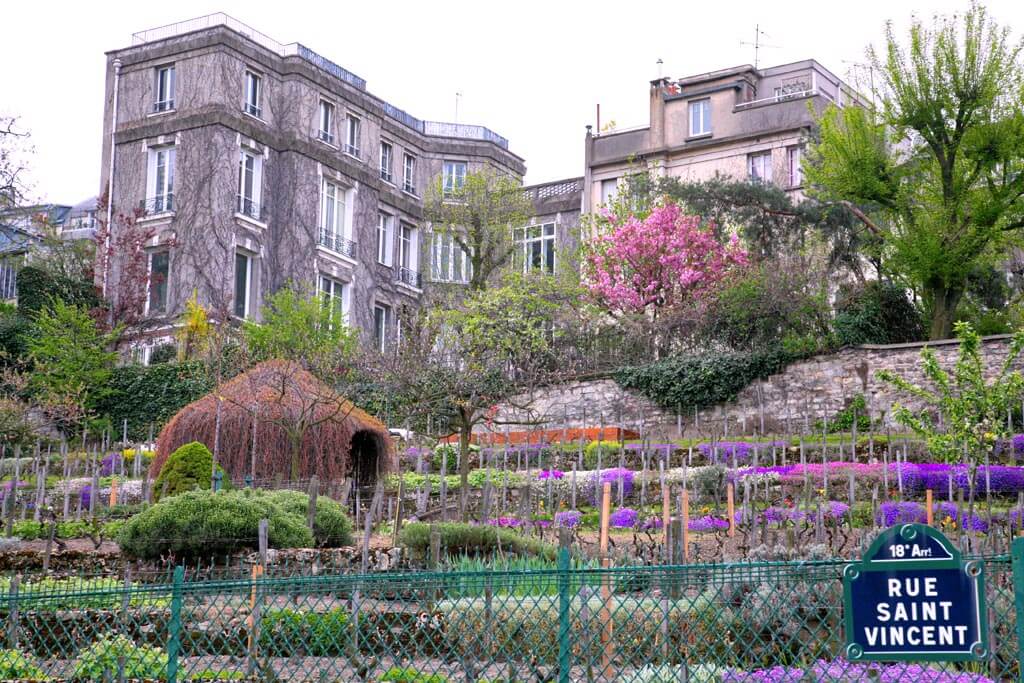
The Montmartre vineyards of Rue Sait Vincent, whose official name is Clos-Montmartre, perpetrates the memory and tradition of the many vineyards that used to cover these slopes.
In the 16th century, the inhabitants of Montmartre – then a village located outside Paris – were mainly laborers-winegrowers. The vineyards were cultivated from the top of the Butte to the surrounding plains.
In the 17th century, the Montmartre wine was a small wine reserved for local consumption. A popular saying of the time makes fun of its quality which seems to be exclusively diuretic: “It is the wine from Montmartre – Who drinks a pint, pisses a quarter of it!”.
This vineyard in Rue Saint Vincent was planted in 1933 to prevent any new construction on the grounds of a former (then abandoned) open-air dance hall called Le Parc de la Belle Gabrielle. Today, this vineyard includes “the most classic varieties from the wine provinces of France, as well as a selection of vigorous and fertile hybrids”. The whole is embellished by decorative plantations.
Public access is not permitted, except for exceptional occasions, such as the Fête des Jardins organized every autumn since 1997. The yearly harvest is generally in early October. The crop is hauled to the Mairie of the 18th Arrondissement cellars, and the 800-odd bottles of wine are sold at auction the following year during the popular Montmartre’s Harvest Festival.
6. Cabaret Life in Montmartre
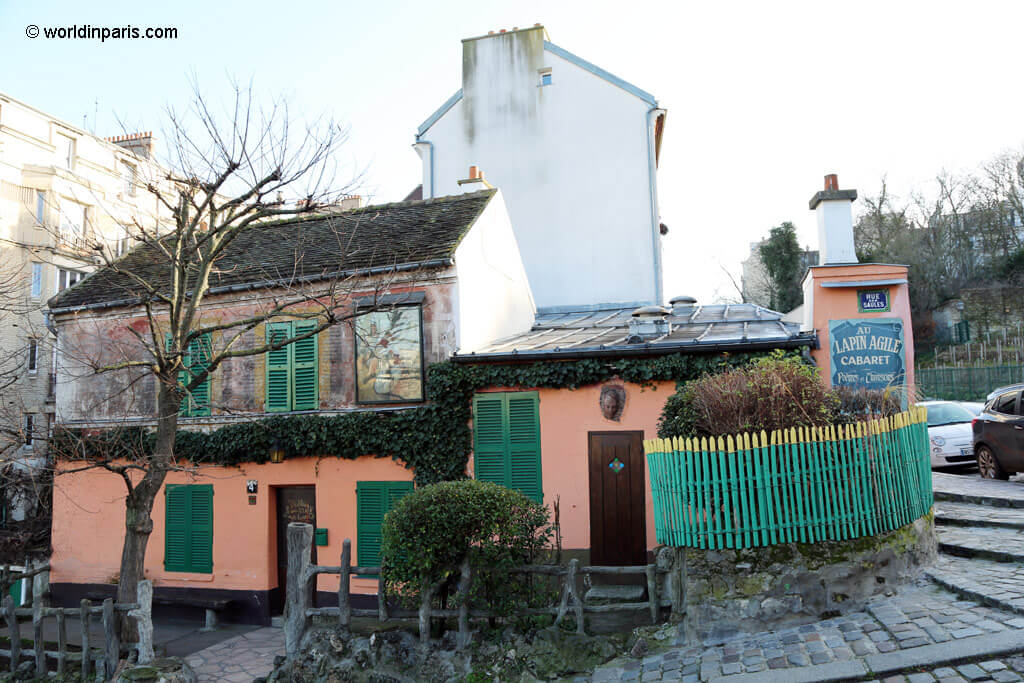
Le Lapin Agile at 22 Rue des Saules is a traditional cabaret established in the second half of the 19th century, bought by Aristide Bruant in 1913. We know that in 1886 this was a restaurant run by Adèle Decerf whose specialty was sautéed rabbit.
In the early 20th century, this village-style house was the center of bohemian life in Montmartre. Dorgelès, Carco, Renoir, Courteline, Forain, Picasso, Fargue, Utrillo, Van Gogh, Clemenceau, and many more were frequent guests of this cabaret. Picasso liked sitting out on the terrace beneath the giant acacia with his dog Frika.
Today, the Lapin Agile has preserved the original and warm atmosphere of the cabarets. You can read more about the Lapin Agile and other Parisian Cabarets in our quick guide to the Cabarets of Paris.
7. Rue de l’Abrevoir
Let’s walk up Rue des Saules, then turn right onto Rue de l’Abrevoir. In the 19th century, the residents of Montmartre followed this path to fetch water for themselves and to lead horses and cattle to the watering trough (abrevoir in French) located on this street. The 19th-century house at #15 is the site of that old watering trough.
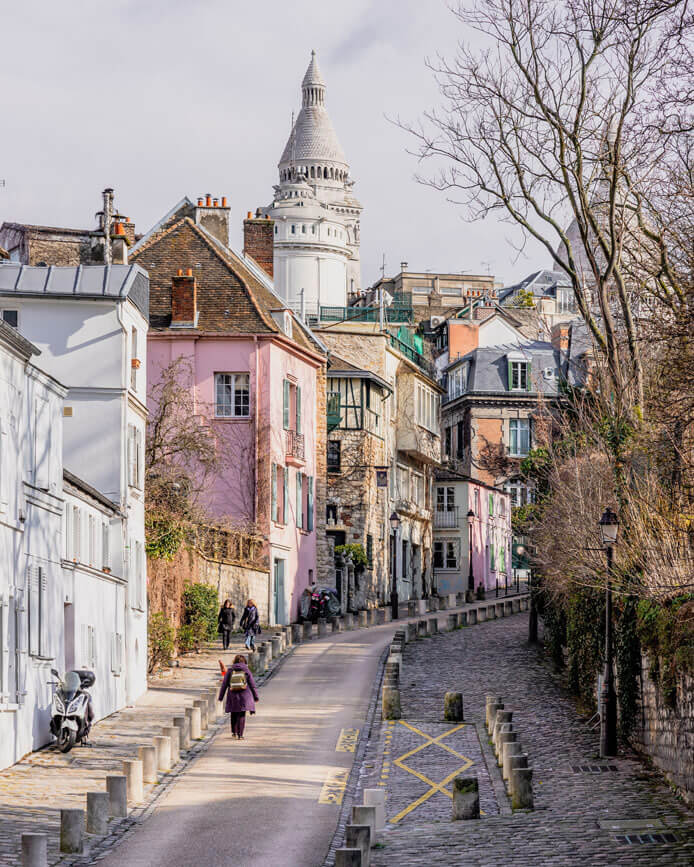
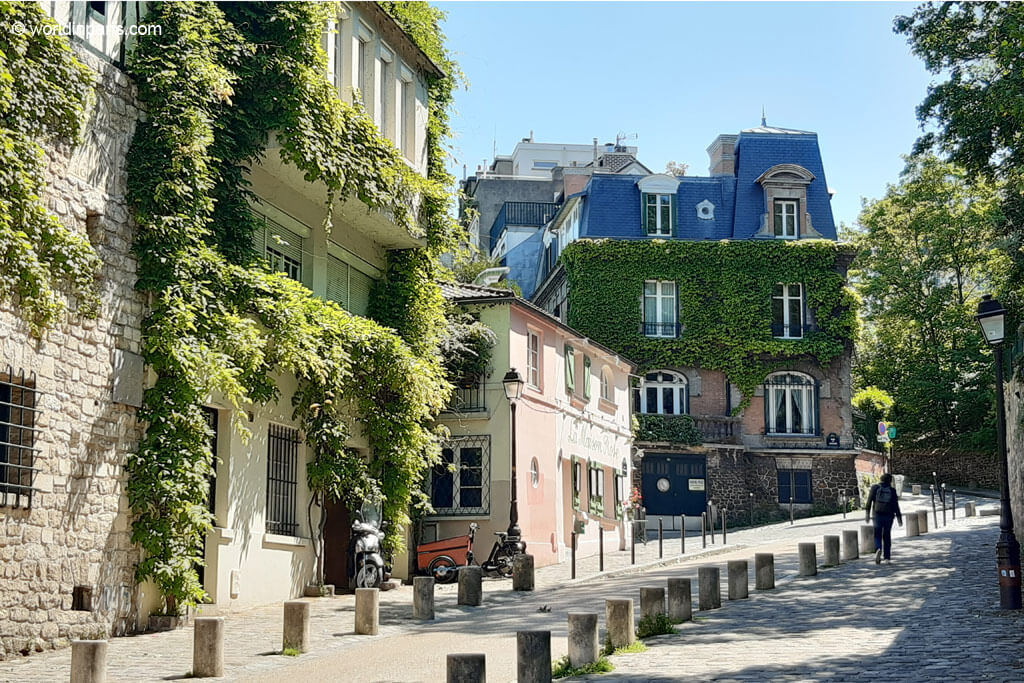
At #2, the little Maison Rose (point #8 on the Montmartre walking tour map) painted by Maurice Utrillo is now a legendary spot in Montmartre and one of Instagrammers’ favorite spots in Paris.
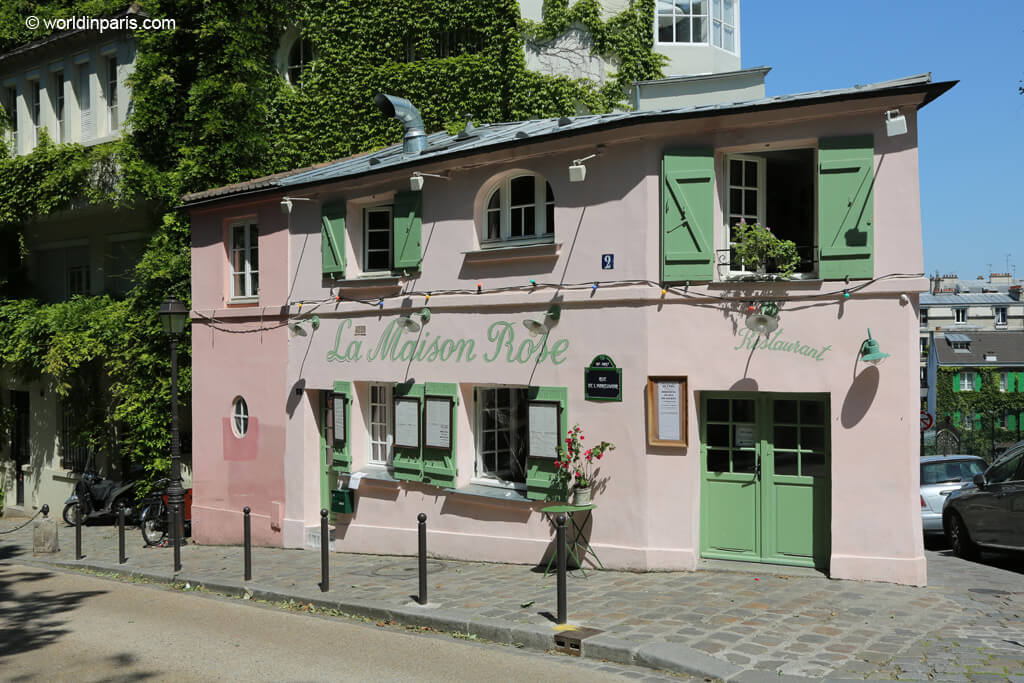
9. Dalida’s Tragic Life
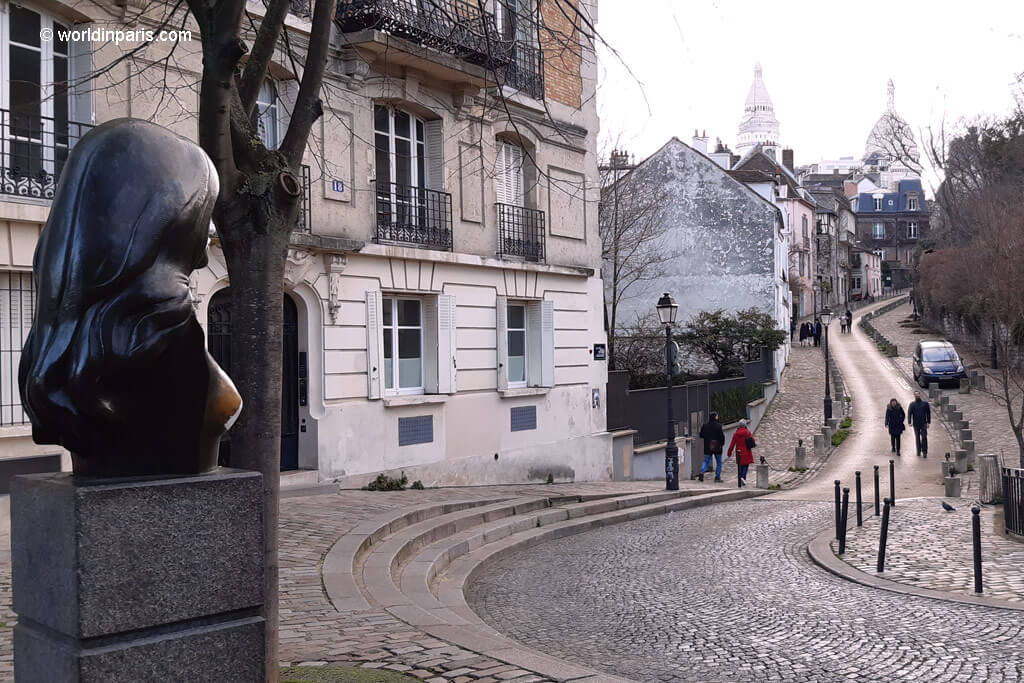
This Montmartre tour stops for a break at Place Dalida. This tiny square has one of the most beautiful views of Montmartre, with Rue de l’Abrevoir towards the Sacré-Coeur. The square is dedicated to Dalida, a famous pop singer who lived in Montmartre. Her incredible talent as a performer made her an icon of pop music in France.
The singer Dalida found a home in Montmartre, where she moved in 1962. She bought a beautiful mansion on the narrow 11 bis Rue d’Orchampt. She used to eat at the neighboring Italian restaurant Grazziano, down by the Moulin, and she also frequented the shops in the Rue Lepic. Dalida joined in the fight to defend and protect the Butte, so dear to her.
Weakened by the loss of her former companions (all committed suicide), as well as her friend Mike Brant, the singer died on 2 May 1987, breaking the hearts of the French. “Life is unbearable to me, please forgive me,” were Dalida’s last words. Dalida committed suicide in her house, and she was buried in the Montmartre Cemetery (not included in this Montmartre tour).
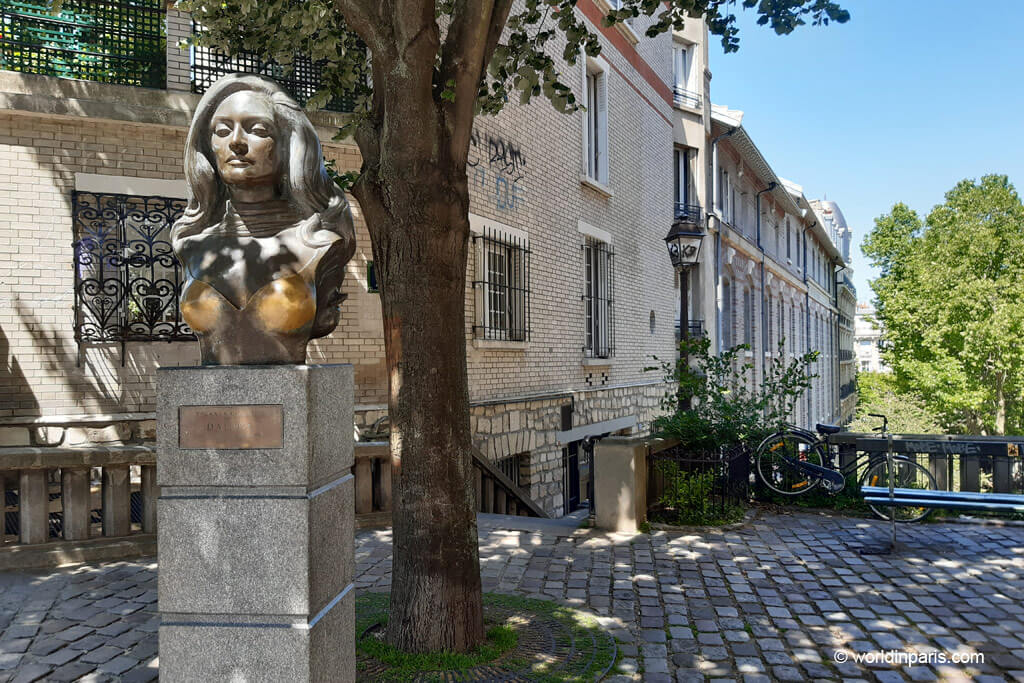
It is soon noticed that the bust dedicated to Dalida is particularly polished in some places – on the artist’s chest, in particular – leaving some visitors doubtful. There is no particular reason for that (unlike Giulietta, Dalida does not bring good luck, love, or money but quite the opposite…) so please be respectful towards this great artist and Montmartroise.
10. L’Allée des Brouillards
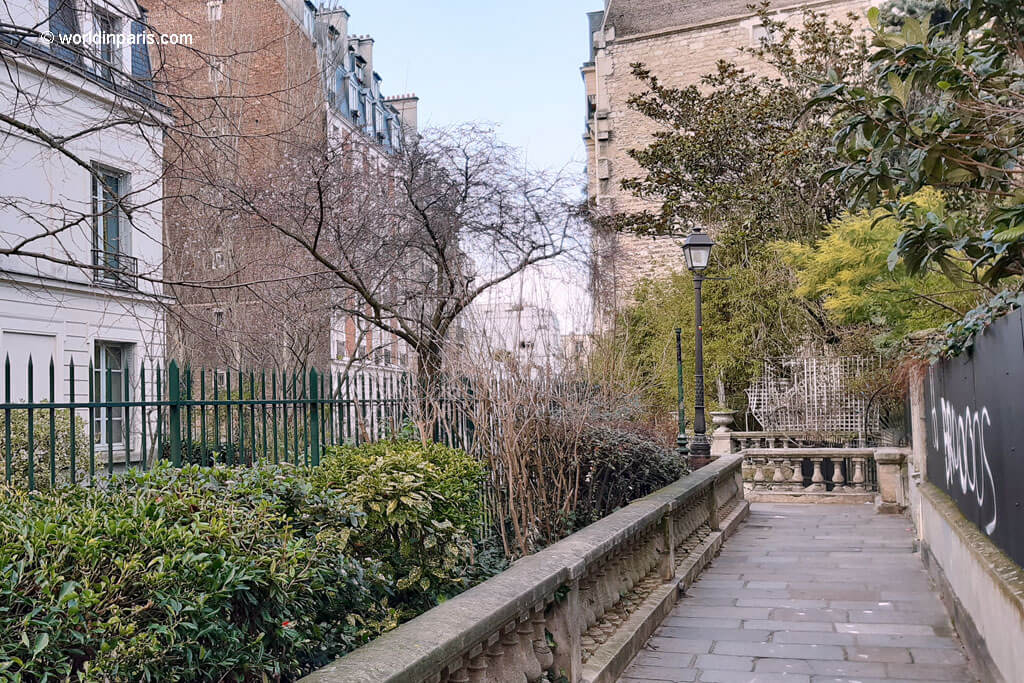
The romantic Allée des Brouillards is one of the few places that still can transport us back in time to the picturesque village of Montmartre. Renoir and his family lived at #8 from 1890 to 1897. His son, Jean, a famous film director, was born here in 1894.
On the right, behind a lawn, rises the delightful facade of the Château des Brouillards, in front of which so many painters set up their easels in the past.
In the 17th century, a modest farm and a mill occupied this site (the Moulin des Brouillards), which served as a press for Montmartre’s (not-so-good) wine. The name Allée des Brouillards (Mists Alley) tends toward two explanations: the morning mists generated by the abundance of the sources in the area or (another one much more festive) an allusion to the vapors of the wine.
In 1764, the hovel and the ruined mill were sold to a lawyer in the French Parliament who built a beautiful house, the ‘Château des Brouillards,’ parts of which you can still see today on the left side. The Château comprised a farmyard, orchard, cellars, and wells, and it was a pleasant country residence.
In 1850 the outbuildings of the Château were torn down to make room for individual houses separated by mere hedges, now on the tiny alley with the poetic name. Its park, gradually invaded by miserable huts, became the famous “maquis” (bush), so dear to nostalgic Montmartrois.
It was not until the 1920s that the castle owner began to restore it. He launched a campaign for its conservation because the City of Paris wanted to remove the old alley and demolish the house. Today, the Château des Brouillards receives the visit of many walkers and lovers of Montmartre in search of an air of the rural and picturesque Butte of better days.
11. Villa Léandre
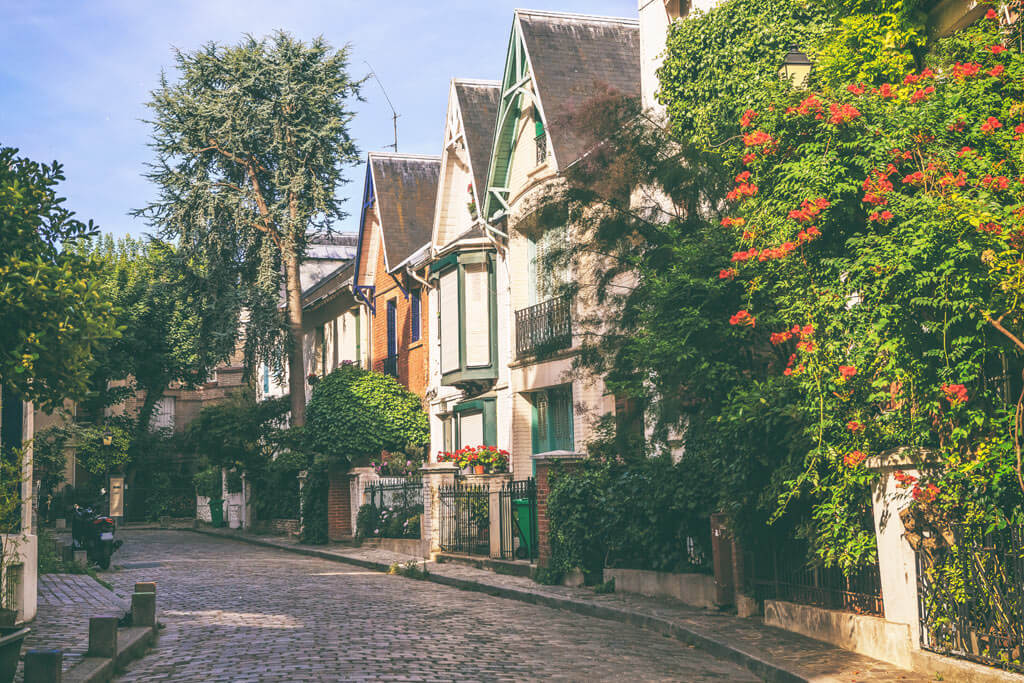
This walking tour Montmartre takes now Rue Simon-Dereure and then Avenue Junot on the left. Before walking uphill, stop at the charming Villa Léandre for a couple of pictures.
Created in 1926, Villa Léandre was initially named Villa Junot, after its larger street tributary. Its current name comes from the caricature artist Charles Léandre, whose studio was located nearby. The cobbled cul de sac is lined with colorful anglo-Normand style houses covered with climbing plants and with small front yards.
Montmartre Things to Do and Hidden Gems
12. The Mysterious Witch’s Rock
The Passage de la Sorcière, accessible from 23 Avenue Junot or 65 rue Lepic, is one of the most pleasant and privileged little alleys in Montmartre. But this little corner of the Butte comes with many legends! Among the mysterious stories linked to this passage, we find the legend around the imposing block of stone found in its center – La Roche de la Sorcière (the Witch’s Rock).
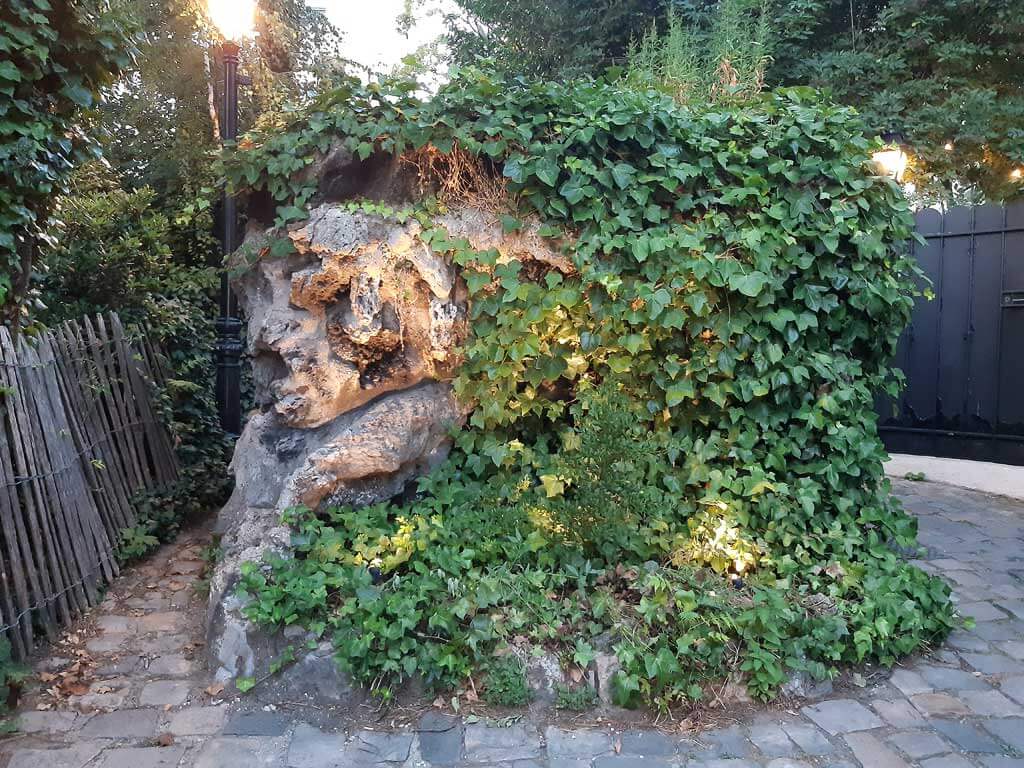
The inhabitants of Montmartre had long believed that this rock was a meteorite, which fell there we do not know when, or how … and it was a magic tool used to protect a witch! Indeed, this imposing rock faces a rather intriguing portal that hides a big and beautiful house. According to legend, this house belonged to an old – and a little bit crazy – woman.
This rock, however, is the vestige of a disused fountain, ‘La Sourcière’ (from source, spring in French), and the neighbors transformed the name of the Passage de la Sourcière, from the name of the fountain which was present there, into Passage de la Sorcière (=Passage of the Witch). Soon, the Rock of the Witch turned into an evil tool with many legends around and spread for generations among the inhabitants of Montmartre.
Today, the witch’s private mansion is one of the most beautiful addresses in the capital, the Hôtel Particulier Montmartre (point #13 on the Montmartre walking tour map). I always recommend this hotel for a romantic stay in Paris which also comes with one of the most beautiful bars in the city. The Hôtel Particulier Montmartre is your only chance to see the Rock of the Witch as this alley is private today.
14. The Legend of Saint-Denis
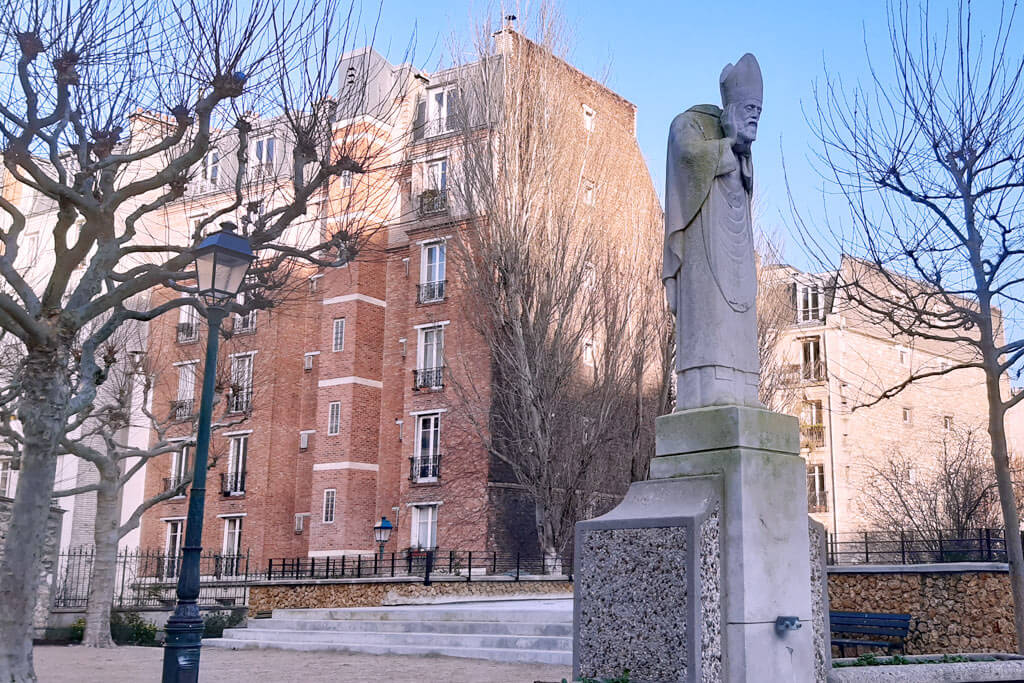
Back to Avenue Junot, this Montmartre self-guided walking tour stops at Square Suzanne-Buisson, dominated by the statue of Saint-Denis. Saint-Denis was the first Christian bishop of Paris in Roman times and the evangelist of the Parisians. The Saint was martyrized and beheaded with his companions Rustique and Éleuthère during Emperor Valerian’s prosecutions.
Legend has it that after his martyrdom (circa 275), the Saint washed his decapitated head in the spring that flowed here until the early 19th century before continuing quietly on his way towards the site where he was buried (current location of the crypt in the Basilica of Saint-Denis). For this reason, the Basilica of Saint-Denis became the burial place for all the Kings of France, who wanted to rest eternally near the remains of the Saint.
15. The Windmills of Montmartre
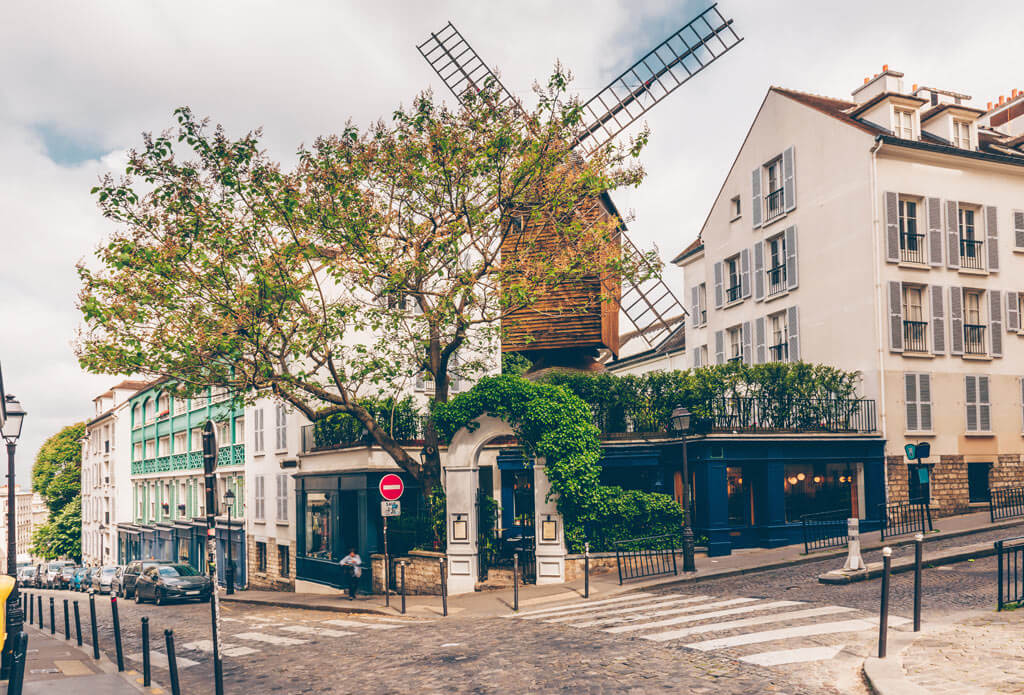
Back to Avenue Junot, on #3, you can get a glimpse of the Moulin of the Blute-Fin, built around 1622. Of the thirteen mills which once stood on the Butte Montmartre, only this one and the Moulin Radet (#16, at the corner of Rue Girardon and Rue Lepic) survive. These windmills were used to grind wheat, press grapes, and crush materials needed in factories.
These two remaining windmills, their surrounding gardens, and a farm made up the popular guinguette (dance hall) Bal du Moulin de la Galette in the 1870s. Every Sunday, the Parisians flocked to the Ball to dance the polka, quadrille, rowdy, and French cancan.
From the 1900s, the Moulin de la Galette gained popularity and quickly became the favorite haunt of many celebrities (painters, designers, actors, etc.). Artists like Renoir, Toulouse-Lautrec, and Picasso immortalized the entertainment of Moulin de la Galette in their paintings.
17. The Fable of the Passe-Murailles
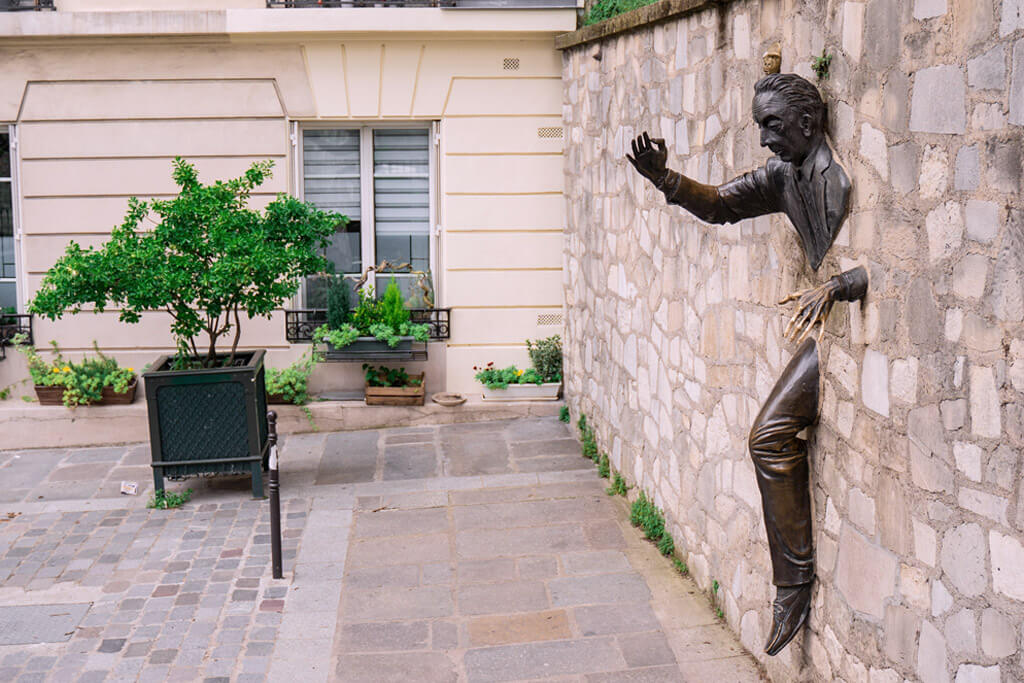
Continue walking Avenue Junot up to Place Marcel-Aymé. This is a beautiful place to see during the cherry blossom season. Here, you can see a man in bronze breaking through the wall.
The Passe-Muraille, the name of the sculpture, personifies a short story written by Marcel Aymé in 1943. ‘An excellent man named Dutilleul had the extraordinary gift of being able to walk through walls without any trouble.’ This is a beautiful homage to the writer, who lived in Montmartre for 40 years.
Go back to the junction with Rue Girardon and then take Rue Orchampt down to Place Émile Goudeau. On the way, you can see Dalida’s house at 11bis Rue Orchampt and some picturesque artist studios.
18. Picasso and Le Bateau Lavoir
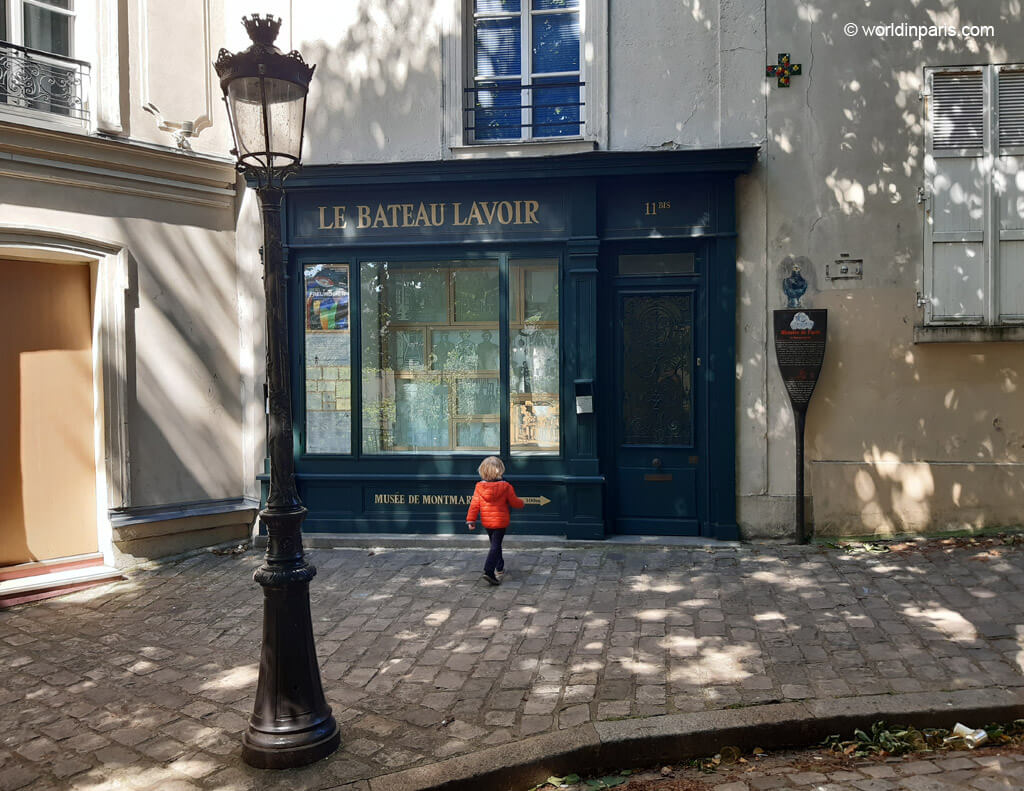
Formerly a ballroom and then a piano factory, the Bateau Lavoir facing Place Émile Goudeau was divided into twenty small workshops for artists. The place was without heating and provided with a single water point.
The Bateau-Lavoir hosted a good part of all the art people of the time: Le Douanier Rousseau, Amedeo Modigliani, Henri Matisse, Georges Braque, Guillaume Apollinaire, Jean Cocteau… All went through the small, cramped workshops of this unusual house.
Until his death, Pablo Picasso (1881-1973) kept nostalgia for the rural Montmartre of his youth, with its picturesque farms, orchards, and cabarets. The artist arrived at the Butte at 19, and he took up a workshop at Le Bateau Lavoir in 1904. Here, he executed the last works of the blue period, those of the pink period – inspired by his love for Fernande Olivier – and The Young Ladies of Avignon (1907), a prelude to cubism.
In 1970, the Bateau Lavoir’s wooden structure did not resist a terrible fire and only the facade, today listed as a historical monument, survived.
19. Place des Abbesses
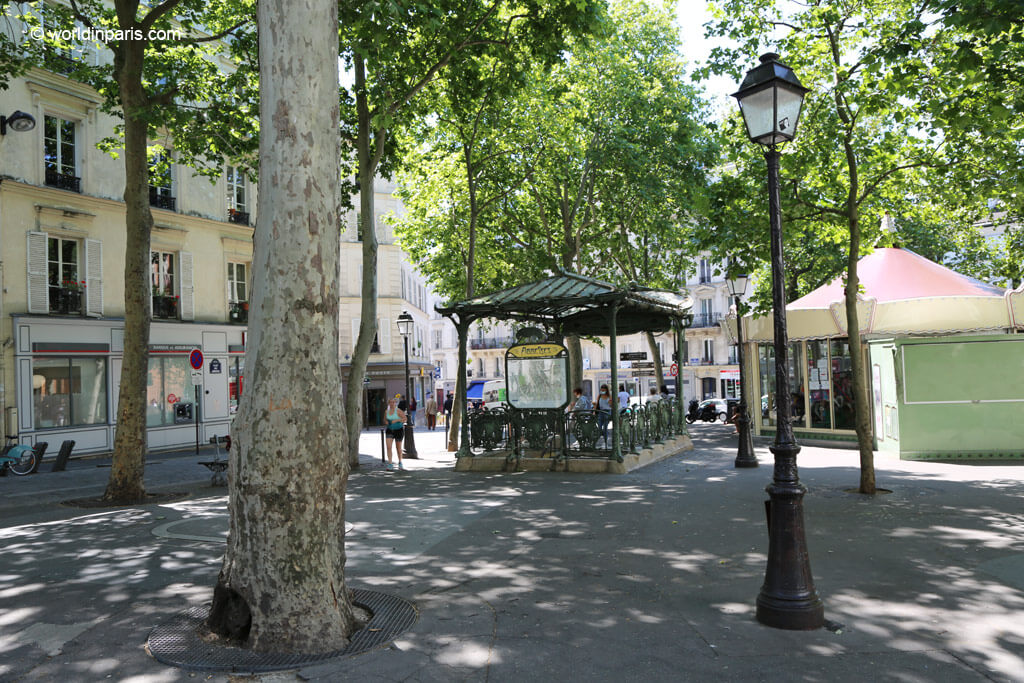
The last stop of this Montmartre walking tour is the picturesque Place des Abbesses. Take your time to explore this lively square with a carousel, some benches in the shade, and the Guimard metro entrance.
Metro Abbesses is the deepest metro station in Paris; it goes 36 m below the ground!
Also interesting is the Church of Saint-Jean de Montmartre (1894-1904), designed by Anatole de Baudot. He conceived the idea of social and economic architecture in harmony with the industrial development of the time. For this building, Anatole de Baudot dared to introduce cast iron and reinforced cement with (in my opinion) a beautiful result.
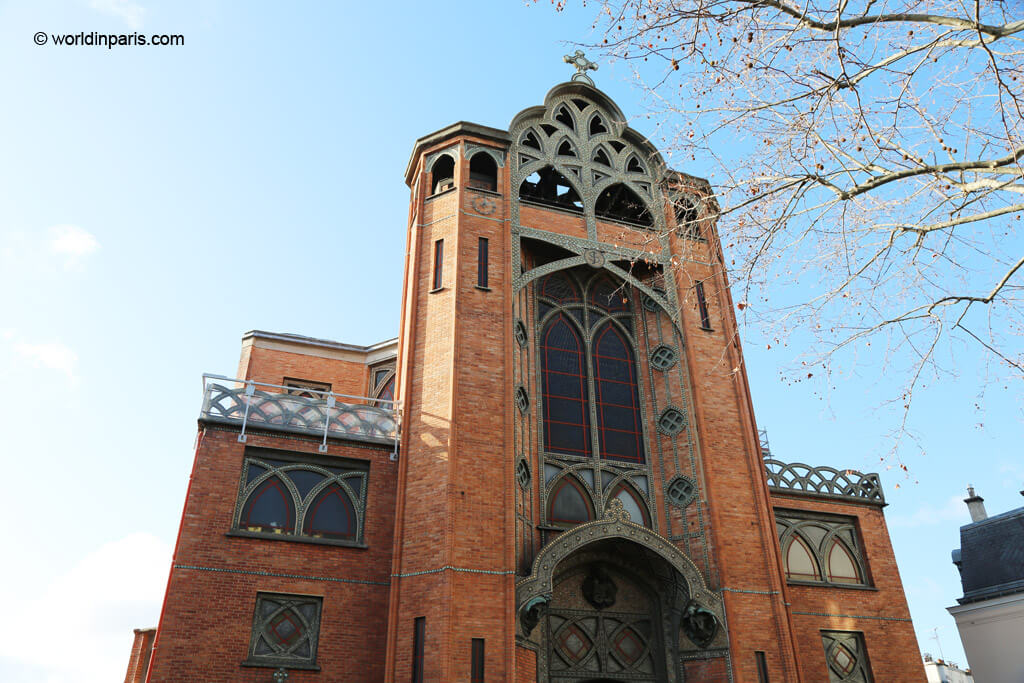
Nearby, in Square Jean Rictus (point #20 on the Montmartre walking tour map), you can see the famous Love Wall, but it is always swarming with people. Instead, make your way to its back corner to discover the hidden Jardin des Abbesses, a lovely small oasis in Montmartre.
After the Love Wall, this Montmartre walk ends at the picturesque café Le Vrai Paris at 33 Rue des Abbesses (#21) for a more than deserved drink and quick eats.
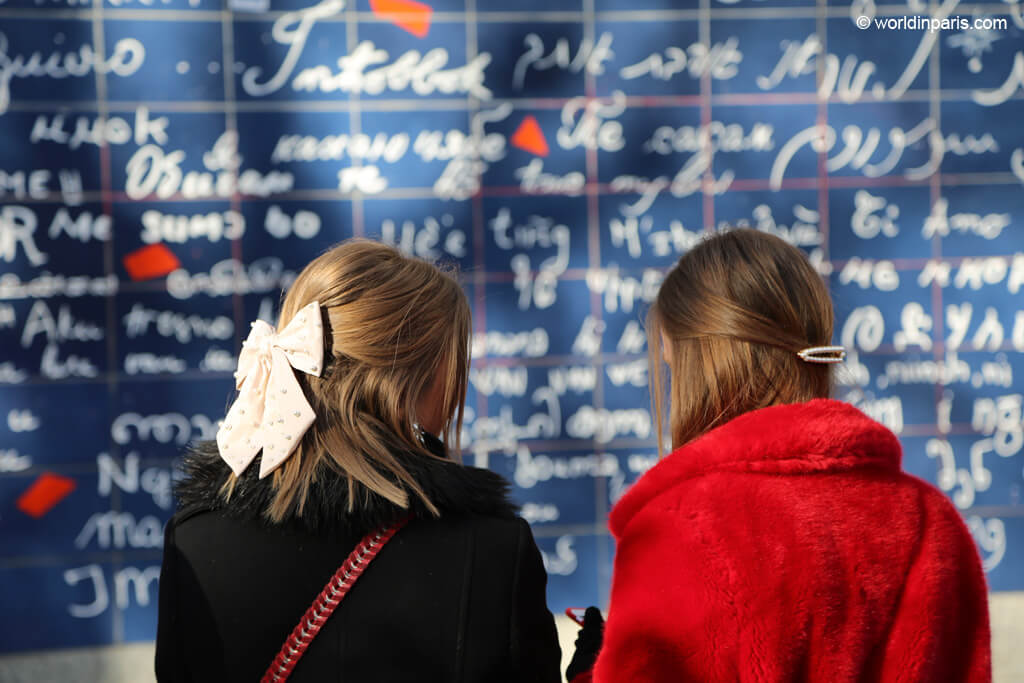

Click here to read about other Paris Attractions
Pin it now & read it later
